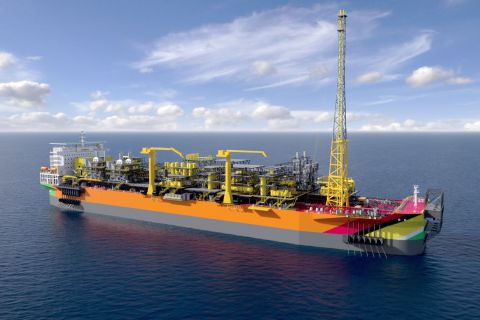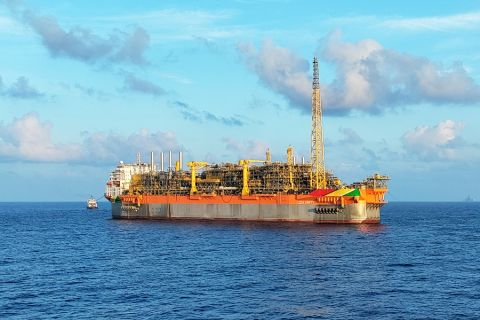Presented by:
[Editor's note: A version of this story appears in the June 2021 issue of Oil and Gas Investor magazine. Subscribe to the magazine here.]
To dividend or not to dividend? That is the question.
It’s all about the investor: Put some money into his or her pocket. Stock appreciation comes first. Since last fall, investors should be pleased: Most E&P equities have soared. Some have more than doubled or tripled, albeit rebounding from woeful lows.
Stock buybacks also are a popular way to add value as investors now demand—and expect—returns from an energy industry that historically has performed badly on that score.
But paying a dividend is gathering a lot of traction. As free cash flow (FCF) is reached, more E&P companies can consider it. This makes sense because paying one is a key trait of mature companies in mature industries, which the shale world is becoming.
That’s been true for the majors for decades. Some 65 companies make the S&P Dividend Aristocrats list, first published in 1989. This is a group that has raised their dividend for at least 25 consecutive years. Only two oil companies are on the list: Exxon Mobil Corp. and Chevron Corp. But even the mighty Exxon Mobil’s cash flow last year only covered 70% of capex, and none of the dividend.
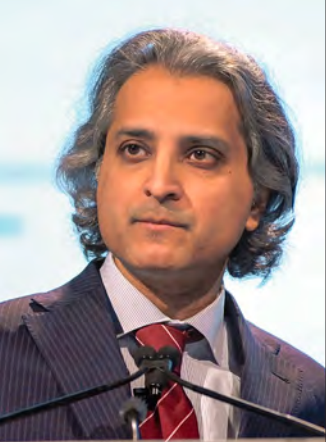
By one count, in fourth-quarter 2020 some 30 E&Ps paid a dividend, many because they had cut spending so much that they had the cash on hand. Companies that reduced or eliminated their dividend last year during the downturn are bringing them back now that the oil price is rising. Several other E&Ps are pledging to pay one soon.
“The industry’s coming around to the notion that growth scares the market, and investors prefer a dollar in their own pocket, not sitting in the company’s pocket,” said Subash Chandra, an analyst with Northland Capital Markets.
Morgan Stanley analyst Devin McDermott wrote that his E&P coverage group “has broadly embraced capital allocation frameworks, limiting growth while transitioning toward a model of sustainable FCF generation and shareholder return.
“Now, with these strategies in place and FCF set to inflect, we expect investor focus will shift toward initial uses of FCF. Leverage reductions will likely remain the priority for most … however, we could see incremental capital return announcements from others, including special dividends … and buyback optionality.”
Many are setting the bar high by declaring a certain percentage of their FCF will be returned to shareholders. Exhibit A: On Pioneer Natural Resources Co. McDermott explained, “PXD proposes to reinvest 70% to 80% of cash flow (versus an average of 122% over the past five years) and target at least 10% total annual return to shareholders, which will include a new variable dividend (to be adopted in 2021) on top of growing the base dividend, while increasing oil production at least 5% annually (prior target of mid-teens). The company continues to maintain its commitment to a low leverage profile.”
In March, ConocoPhillips Co. resumed its $1.5 billion share repurchase plan, and CEO Ryan Lance reaffirmed the priority is to return greater than 30% of cash from operations to shareholders annually—by its dividend and the repurchase plan.
In February, Cabot Oil & Gas Corp. announced a variable dividend and its intent to return 50% of all FCF to shareholders, adding to its current quarterly dividend. The variable plus the base will add up to 50% of FCF. The variable dividend will be paid annually starting in fourth-quarter 2021.

PDC Energy Inc. has said it will first pay down more debt and continue stock buybacks, but it may initiate a dividend by midyear. Executives at Cimarex Energy Corp. and Cabot Oil & Gas have told investors they are considering more payouts. Cimarex may institute a variable dividend, and Cabot may pay a base-plus supplemental payout to up its strategy for returning capital to shareholders.
Gabe Daoud Jr. of Cowen & Co. listed Cimarex as a top stock pick for 2021, citing the dividend as one of the reasons. “Overall, our model suggests XEC [Cimarex Energy] can deliver best-in-class FCF yield (about 12%) that supports a growing base dividend (about 3%), alongside retirement of the ’24 notes ($750 million).” Truist analyst Neal Dingmann expects that this trend will continue. “I view a variable dividend as a better alternative to common share repurchases seen in prior years,” he wrote in an email to Barron’s.
Hess Corp. and Murphy Oil Corp. said they plan to focus on maintaining free cash flow and paying down debt over production growth, to be followed later by dividend increases or share buybacks. Hiking capex with new-found cash flow is on the back burner now that investors do not want to see much growth.
Marathon Oil Corp.’s top priority of free cash flow is to continue to pay the base dividend and improve the balance sheet to its 1.0x to 1.5x leverage target, said analyst Gabriele Sorbara of Siebert Williams in a report. “Once these goals are achieved, we expect MRO to increase the base dividend or establish a variable dividend and consider buybacks.”
Just before first-quarter conference calls began in April and May, KeyBanc analyst Leo Mariani said he anticipates more dividends to come. “Looking ahead to 2H21, we think COP could raise its dividend this fall, and we expect BRY [Berry Petroleum Corp.] to raise its dividend in 2H21 as well. Additionally, we think MGY [Magnolia Oil & Gas Corp.] may give numbers around its dividend by 3Q21, and we think CLR [Continental Resources Inc.] may reinstate its dividend in 2H21.
“Lastly, we think DEN [Denbury Inc.], WLL [Whiting Petroleum Corp.] and XOG [Extraction Oil & Gas Inc.] could initiate dividends in late 2021/early 2022 as return of capital restrictions roll off of their credit facilities post-bankruptcy.”
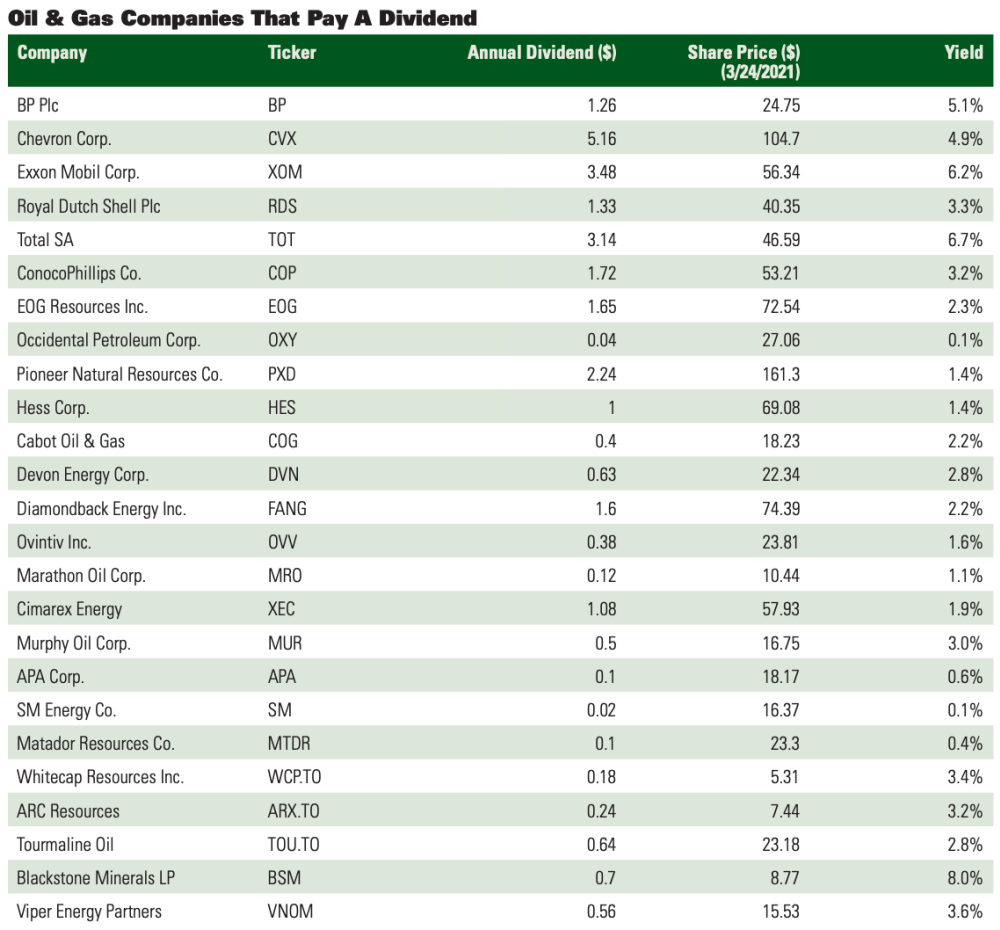
How much do dividends matter?
People like dividends, but some investors and analysts continue to be a bit skeptical as well, given the boom-bust nature of the business.
“It’s very important for signaling to the market that they are disciplined, but some of these companies are still not out of the woods,” said Mark Lear, a Simmons Energy analyst who covers the large caps.
“It’s a step in the right direction. But I’ve been a bit underwhelmed by those companies who introduce, increase or have a variable dividend. It’s a bit of a ‘show me’ thing and then investors will begin to sniff around again. I think it’s still early.”

There is some question, too, of whether paying a dividend matters to a company’s stock performance. “There is not a great correlation yet between paying a dividend and your stock price. I don’t think the market knows what it wants yet,” said Chandra.
“The stock performance has less to do with return of capital and more to do with NAV [net asset value] true-up. Antero Resources Corp. was probably one of the top stock performers last year, and they don’t pay a dividend and aren’t even close to paying one. The stock is up because of what it’s actually worth [NAV].” Antero has said it will not pay a dividend, but rather, will plow cash flow back into the business.
First things first
In some ways paying a dividend is a luxury E&Ps cannot afford, although investors may think it’s a necessity. In Chandra’s mind, it is more important to use free cash flow to eliminate bank debt and fixed obligations. “Once you are at your debt target then you can think about how to pay out your return on capital.”
Lear echoed that, saying, “First and foremost, companies should focus on their balance sheets and debt maturities. Cash burns a hole in a company’s pocket, but it’s not necessarily bad to have it on the balance sheet,” he told Oil and Gas Investor.
He said stock buybacks can be very valuable as well, but some companies don’t have a good track record on that score. If commodity prices rise and cash flow does too, deploying it to buy back stock occurs at a time when the stock is expensive. Buybacks are often ill-timed, he said.
Setting realistic expectations in an uncertain commodity environment plays a role. It’s important to consider the overall health of a company and the direction it is going, said Trey Cowan, CFA, and oil and gas analyst for the Institute for Energy Economics and Financial Analysis (IEEFA), which has reported on total shareholder return trends.
“Yield might be important and a nice bump, but there’s more to it than that,” he said. Dividend yield is a function of the annual dividend paid, divided by the current stock price, which can vary wildly due to any number of factors that a company cannot control.
“What tends to happen is that investors don’t look at a dividend yield. They instead ask the questions, ‘Has the dividend grown over time and will it continue to grow? Are they confident that the company will continue to return a portion of its capital to investors?’ Nothing is certain but if a company consistently raised its dividend over time, and hasn’t disappointed, then that is more attractive than what the yield is,” Cowan said.
A high dividend yield of 10%, 15% or more probably indicates that the stock has been beaten down and investors have lost confidence (or, that the company has not adjusted its dividend in response to tough times). A typical retail investor looks for a yield that is above the 10- year Treasury, which is currently less than 2%. Institutions are managing their portfolio to see what gives them a high enough return to meet their investing criteria, which is a stock appreciation game plus the dividend.
Devon Energy Corp. pays 19 cents per share on top of the base of 11 cents. On an annualized basis that translates to a yield of 5%, versus the 2% yield it had before.
“There is a subset of investment funds which only hold stocks that pay a dividend, even if it is essentially symbolic, such as one penny. I’m not aware of any data on how large these funds are, but they exist. So, all else being equal, it is better to pay one penny than nothing at all,” Pavel Molchanov, a Raymond James analyst, told Oil and Gas Investor.
“That being said, investors that are truly focused on income typically prefer stocks with yields at least at the level of the S&P 500, which is currently 1.3%.
“What is emphatically not a good idea is when companies borrow to pay the dividend on a sustained basis. Of course, there can be temporary circumstances—perhaps one or two difficult quarters—when that is appropriate. But generally speaking, dividends should be funded from operating cash flow,” he said.
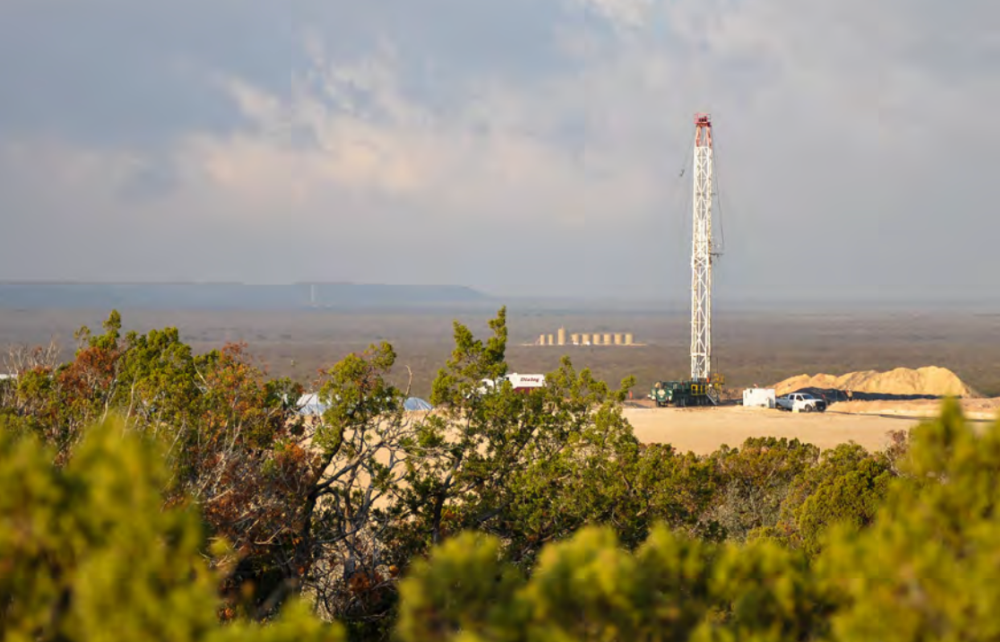
Other benchmarks
How do payouts (dividends and buybacks) by oil and gas firms compare to the rest of the companies in the broad S&P 1500? In February, CFO magazine cited findings by Analysis Group, which looked at payout trends in the S&P 1500 from 1999 to 2019 (before the pandemic disrupted all financial metrics). Payouts have been increasing over the 20-year period.
“In 1999, for HPOCs (high payout companies in the S&P 1500), the median value for the ratio of payouts to operating income was 47%; in 2019, the median shot up to 69%. In other words, the typical HPOC in 1999 paid out a little less than 50 cents of every dollar of operating income. Twenty years later, the typical HPOC paid shareholders 69 cents of every dollar of operating income.
“For both HPOCs and non-HPOCs, the buyback portion of distributions increased much more dramatically than the dividend portion,” the report found.
“Overall, the median shareholder payout ratio for non-HPOCs has been slowly converging toward the reinvestment ratio. That suggests that shareholder distributions are becoming a more important element of capital allocation strategies, even for businesses taking a more conservative financial path,” the magazine said.
Simmons Energy compiled data that show that the average dividend yield varies by size of E&P companies. For the mega-caps on its list (BP Plc, Chevron, Conoco, Exxon Mobil and Occidental Petroleum Corp.), it is 3.6%. For the large-cap independents it studied (Apache Corp., Devon Energy, Pioneer, Murphy Oil, Cimarex Energy) it is about half that or 1.5%.
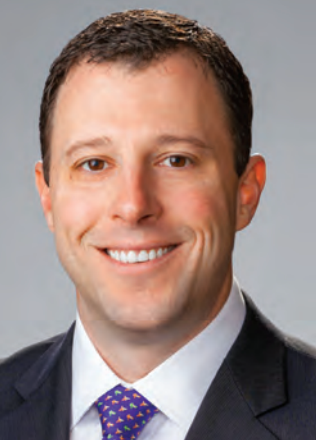
The oil-levered small and midcap group (SMIDs) included Centennial Resource Development Inc., Magnolia, Laredo Petroleum Inc. and Whiting Petroleum. Their average yield was zero. Gas-levered SMID companies fared little better, averaging 0.4%. This group included Cabot Oil & Gas, CNX Resources Corp. and EQT Corp.
Dividend, buyback or debt?
As CFOs contemplate how best to share cash flow with their investors, several choices are available. “Our view is that E&Ps have to find a way to return value (ultimately cash) to their investors, which they can do in one of three ways: stock appreciation, cash sale of the company or dividends,” said Josh Sherman, partner in charge of the complex financial reporting group at Opportune LLP.
“Whether a company chooses to use available cash on development, paying-down debt, acquisitions or dividends says a lot about the current state and perspective of the company, industry and management team,” he told Oil and Gas Investor.
“For a return of capital, I’d rather have a dollar in my pocket from a dividend than have a dollar to buy back stock,” said Chandra.
Opportune looked at publicly traded E&P companies on U.S. exchanges (plus Shell and Imperial Oil) with a market cap over $1 billion to analyze how their dividend policies affected their stock/total returns versus changes in commodity prices.
“Overall, it’s not surprising that overall stock returns appeared mostly affected by commodity prices; however, we did note that companies that increased dividends fared slightly better in the 2020 downturn,” Sherman said. Out of the 34 companies reviewed, 16 decreased dividends; 15 increased dividends; and three held dividends constant.
“The most surprising analysis was that the three companies that paid zero dividends in 2020 (EQT and Range Resources Corp. reduced their dividend to $0; CNX remained at $0) were the only companies that had a positive stock return in 2020,” Sherman said.
“While dividends paid by other companies lessened the blow, the stock returns of these three companies are likely a market mandate for well-run companies focused on natural gas/ ESG (versus oil),” the Opportune report said.
“Whether a company chooses to use available cash on development, paying-down debt, acquisitions or dividends says a lot about the current state and perspective of the company, industry and management team.”
—Josh Sherman, Opportune LLP
The decision to pay a dividend should be based on which choice will optimize a company’s financial position and what is most cost-effective. There are mathematical formulas to help figure this out, Cowan said. Chandra said the market is looking for who can maintain production and throw off free cash flow, so companies must decide what the most robust approach is that enables them to do this, and at the same time, help them to survive any subsequent downturns.
IEEFA study
The IEEFA found that 30 shale producers generated $1.8 billion in free cash flows last year—after slashing capital spending by $20 billion from the previous year.
“During 2020, four of the world’s five largest private sector oil and gas companies failed to generate enough cash from their primary business—selling oil, gas, refined products and petrochemicals—to cover their cash payments to shareholders,” said the IEEFA report.
“Exxon Mobil paid $17.8 billion more to shareholders during the year than it generated from its core business operations; Chevron paid $9.5 billion more; BP paid $7.3 billion more; and Total SA rewarded its shareholders with $2.9 billion more than it generated. Only Shell broke from its peers, generating an $8 billion cash surplus. To do so, however, the company reduced dividends by two-thirds (the firm’s first per-share dividend cut since 1945), while suspending share buybacks and slashing capital expenditures by 28% year-over-year.”
RELATED:
Shale Industry’s Dilemma Persists Despite Free Cash Flow Milestone
Investor responses
“Energy investors like to see dividends— provided, of course, that they are adequately covered with cash flow—as a tangible manifestation of management’s commitment to capital discipline. The days of growth for the sake of growth are long gone,” said Molchanov.
“Return of capital—dividends and/or share buybacks—are much more highly prized. The difference between the two is that a share buyback can easily be flexed up or down from quarter to quarter, depending on (among other things) commodity prices, whereas a dividend is regarded as something that is more ‘set in stone.’”
Lear told us it’s difficult to decipher what the market thinks about the dividend versus the oil price leverage, and he noted some M&A activity has come into the picture too. “But it’s very important for signaling to the market they are disciplined. Companies are still a bit concerned that they are not out of the woods yet, but a dividend is a step in the right direction,” Lear said.
“We think the move toward a capital disciplined reinvestment approach and shareholder return model has been positively received by investors. The group has had a strong rebound starting in fourth-quarter 2020, but it’s difficult to say how much is attributed to the anticipated economic recovery and the strategic shift to limit reinvestment and return capital,” he told Oil and Gas Investor.
“We think the latter, paired with capped growth, has the potential to prolong the cycle for E&P. In terms of equity performance, we have seen higher leveraged names that provide oil beta outperform, and those that have the ability to deliver increased shareholder return rather utilize FCF for balance sheet repair have performed well, but they have lagged to some degree. We think over the longer term, a company’s ability to deliver increasing shareholder return will drive outperformance.”
The oil industry can be both a blessing and a curse to dividend investors, according to a comment on The Motley Fool website. “During rough patches such as those in recent years, it can be a challenging place for income-seekers, since weaker companies need to reduce or eliminate their dividends to make it through a downturn.”
Paying a dividend may, in the end, be one way to mitigate the volatility inherent in a risky industry. “Companies can debate how to think about their future but there are some things you can’t do. That’s pretty clear,” Northland’s Chandra said. “This has always been a boom-bust industry but we’re trying to take the bust away. It’s too hard for investors to ride the boom-bust. So one way to do that is to pay down debt.
“Return of capital is important, whether it’s a buyback, paying a variable dividend or a fixed one. I don’t know what the mix is, but if you don’t have free cash flow, it’s a problem.”
Recommended Reading
Pitts: Heavyweight Battle Brewing Between US Supermajors in South America
2024-04-09 - Exxon Mobil took the first swing in defense of its right of first refusal for Hess' interest in Guyana's Stabroek Block, but Chevron isn't backing down.
Iraq to Seek Bids for Oil, Gas Contracts April 27
2024-04-18 - Iraq will auction 30 new oil and gas projects in two licensing rounds distributed across the country.
E&P Highlights: Feb. 26, 2024
2024-02-26 - Here’s a roundup of the latest E&P headlines, including interest in some projects changing hands and new contract awards.
Exxon Mobil Green-lights $12.7B Whiptail Project Offshore Guyana
2024-04-12 - Exxon Mobil’s sixth development in the Stabroek Block will add 250,000 bbl/d capacity when it starts production in 2027.
Exxon Ups Mammoth Offshore Guyana Production by Another 100,000 bbl/d
2024-04-15 - Exxon Mobil, which took a final investment decision on its Whiptail development on April 12, now estimates its six offshore Guyana projects will average gross production of 1.3 MMbbl/d by 2027.


